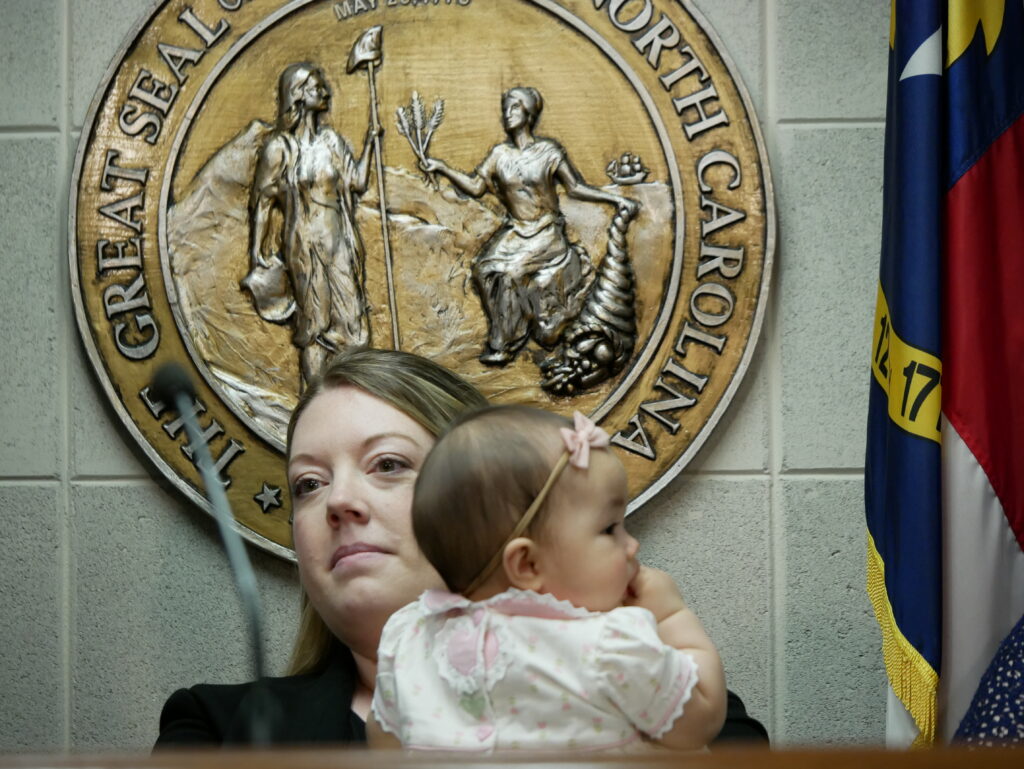
Share this story
- “If we’re going to maintain our superiority as the most attractive place to live and do business in this country, we’re going to have to be serious about talent development, recruitment, and retention," UNC-Chapel Hill's Dr. Jim Johnson said.
- N.C.'s population growth rate is slowing down, but it's still outpacing the country as a whole. Nationally, population growth is slowing due to declining fertility, the graying of the population, restrictive immigration policies, and deaths of despair.
|
|
The multiple factors leading to slowing total population growth across the U.S. will impact the future of higher education, UNC-Chapel Hill’s Dr. Jim Johnson told N.C. community college leaders at a convening on adult learners last week.
Johnson is the William R. Kenan Jr. Distinguished Professor of strategy and entrepreneurship at UNC and the director of the Urban Investment Strategies Center at the Frank Hawkins Kenan Institute of Private Enterprise. His research includes community and economic development, and the effects of demographic changes on the U.S. workplace, among others.
“There are a set of gale-force demographic wind gusts out there – you’re going to have to buckle your seat belt,” he said. “If we’re going to maintain our superiority as the most attractive place to live and do business in this country, we’re going to have to be serious about talent development, recruitment, and retention.”
Sign up for Awake58, our newsletter on all things community college.
The country’s population increased 7.4% from 2010-2020, Johnson told attendees, citing census data. That rate is one of the lowest in the country’s history, second only to the 7.3% growth rate from 1930-1940 – during the Great Depression.
In North Carolina, those numbers look a little different.
While the state’s population growth rate is slowing down, it’s still outpacing the country as a whole. Nationally, population growth is slowing due to declining fertility, the graying of the population, restrictive immigration policies, and deaths of despair, Johnson said.
However, in North Carolina, Johnson said the state’s population increase – 9.5% from 2010-2020 – is faster than the U.S. overall largely due to industry growth and people moving to the state.
During the first 15 months of the pandemic, Johnson said of the state’s growth, North Carolina received 253 people every day, seven days a week. Three quarters of North Carolina’s growth last fiscal year was attributed to domestic migration, according to a News & Observer report, while net international migration added about 26,000 residents.
Understanding the data
Though North Carolina has seen faster growth compared to many other states, Johnson cautioned higher education leaders from writing off the national data.
“Don’t get lulled to sleep by the boom,” he said. “Because nationally we’re experiencing this slower rate of growth in everything that we do.”
Higher education institutions, including community colleges, must proactively work to engage students in light of declining population growth, he said.
Johnson cited several contributing factors to declining population and enrollment trends, listed below.
- National restrictive policies on immigration
- National decline of white population
- Declining fertility
- Graying of the U.S. and N.C.
- The plight of men and declining male enrollment
- Drug overdose deaths soaring during the pandemic
- Declining female labor force participation and involuntary retirements
With those factors in mind, let’s take a deeper look at the data.
Immigration and shifting demographics of the population
The rate of immigration growth in the U.S. has decreased dramatically since 1990, Johnson said, citing restrictive immigration policies. From 2016-19, the rate of immigration only increased 2.7% nationally.
In North Carolina, the rate of immigration increased 12% during the same time period. However, that rate is down from nearly 23% from 2010-2019.
Why does such data matter? Historically, young people migrate more than older people do, Johnson said, meaning they are more likely to have children. Immigrants also hold millions of important jobs in the workforce.
Despite slowing rates of immigration, the immigrant share of the U.S. population (13.7%) is nearing the country’s historic high (14.8% in 1890), according to 2020 Pew Research data.
The U.S. is also becoming less white, Johnson said. The 2020 census showed the first decrease of the white population in the U.S. – down by 2.6% from 2010-2020. In North Carolina, the white population increased by 1.4%.
A report on the census from Carolina Demography cautions against focusing on declines in the white population, noting changes in how the 2020 Census asked about race and ethnicity.
“The big story here is the significant increase in the share of individuals identifying as Multiracial (two or more races),” that report says. “In North Carolina, this population more than doubled, growing by 161% or an increase of 251,094.”
“The Browning of America,” Johnson told attendees, means that employers and colleges must better serve and engage students of color.
“Ninety percent our net growth in this country has been driven by people of color,” Johnson said. “And so that’s the population that we’re talking about tapping into and developing.”
Declining fertility
“The other thing that’s driving slowing growth is a decline in fertility,” Johnson said. “If you are a couple, you need to have 2.1 kids to replace yourself – please don’t ask me about the .1.”
Declining fertility means that deaths in a population often exceed births.
In North Carolina, 84 counties saw more deaths than births between April 1, 2020, and July 1, 2021, according to a Carolina Demography data analysis.
The graying of the population
The population is also getting older, Johnson said.
In North Carolina, the population of people 65 and older increased by 3.7% from 2020-21. In comparison, the 18-64 population increased by 0.8%. The under-18 population decreased by 0.3%.
“And because we’ve got below replacement level fertility and that under-18 population declined – that’s your labor shortage moving forward,” he said.
The ‘plight of men’
“We have a problem with our male population,” Johnson said.
The “plight of men,” Johnson said, includes selectively withdrawing from the labor market, declining male enrollment in higher education, and increasing incarceration. The gender split in college completion rates have remained relatively unchanged over the past 35 years, he said, at about 60% female and 40% male.
“We’ve got a whole generation of men that have given up on college,” he said.
Male enrollment has consistently trailed behind female enrollment in recent decades, but this trend was exacerbated by the pandemic, with community colleges hit hardest.
In fall 2020, the NCCCS saw an overall 11% decline in enrollment compared to fall 2019, EdNC previously reported, with Black men suffering the largest enrollment decline. Experts told EdNC at the time that pandemic-related job shortages, sickness, family, and mental health all further impacted male enrollment declines.
Such trends don’t only impact men, Johnson noted, but their families, and their potential future spouses and children.
Drug overdoses
“And then we got these drug overdose deaths, these deaths of despair,” he said. “Deaths due to what? Suicide, alcohol, drugs abuse, particularly opioids, during the pandemic.”
There were 90,000 drug overdose deaths in 2020, according to CDC data, representing a 30% increase over the 2019 death toll. Many experts cite the isolation and shutdown of in-person treatment and counseling during the first year of the pandemic as contributing factors, Johnson said.
Drug overdoses increased during the pandemic in North Carolina, too.
In North Carolina, a record 4,041 North Carolinians died of an overdose in 2021, a 22% increase from 2020 and a nearly 72% increase from 2019.
“How do we sustain that economic prosperity? You need human capital to be able to do it,” Johnson said. “This is a serious problem.”
Declining female labor force and involuntary retirements
Finally, Johnson cited declining female labor force participation and involuntary retirements as factors increasing the state’s workforce and population growth.
The pandemic forced 2 million women out of work, Johnson said, citing a 2021 report by the National Women’s Law Center based on data from the U.S. Bureau of Labor Statistics.
“We will not be able to solve the great resignation problem until we solve the child care crisis,” Johnson said. “And getting those 2 million women back to work – they have to be able to take care of their children, and making sure that they’re in safe, high-quality, affordable child care is a crucial piece.”

During the pandemic, 1.7 million workers 55 and older were also forced to retire, Johnson said, with Black workers disproportionately impacted. The involuntary retiree’s had a median savings of only $9,000.
“This is the hardest working generation out there,” Johnson said. “We’ve got to figure out how to get them back into the labor market.”
What should we do?
Multiple countries are projected to see smaller workforces in the next decade, Johnson said, including the U.S. By 2036, the U.S. is projected to see a 3.2% decrease in the workforce population, people 15-65.
In N.C., current growth is uneven, with only 49 of the state’s 100 counties having a growing population.
Nearly half of the state’s population growth over the last decade took place in Wake and Mecklenburg counties, at 47% of growth, according to census data presented by Johnson. And 95% of the state’s growth is from just 15 counties.
So, what should N.C. leaders do?
Higher education leaders must first understand the trends, Johnson said. Then, state leaders must advocate for and implement specific and targeted solutions to account for the data.
First, Johnson said, the U.S. needs “a sane immigration policy.” In turn, higher education and community college leaders must offer support and resources specifically for immigrant students.
Next, the state and federal governments must create a child care policy that allows parents to work while also connecting young children to high-quality pre-K. (You can read more about child care policy in North Carolina by reading EdNC’s recent report on the subject.)
Finally, Johnson said the state must take a community approach to dealing with deaths of despair. A person’s zip code shouldn’t determine their quality of life and access to life-saving treatment, he said.
“We are in a serious demographic shift that we have to be thinking about and being mindful of,” Johnson said. “That slowing of the growth of that 25-54 population – that’s our challenge in society.”
Editor’s note: The John M. Belk Endowment supports the work of EducationNC, and sponsored the convening with EdNC.
Recommended reading



